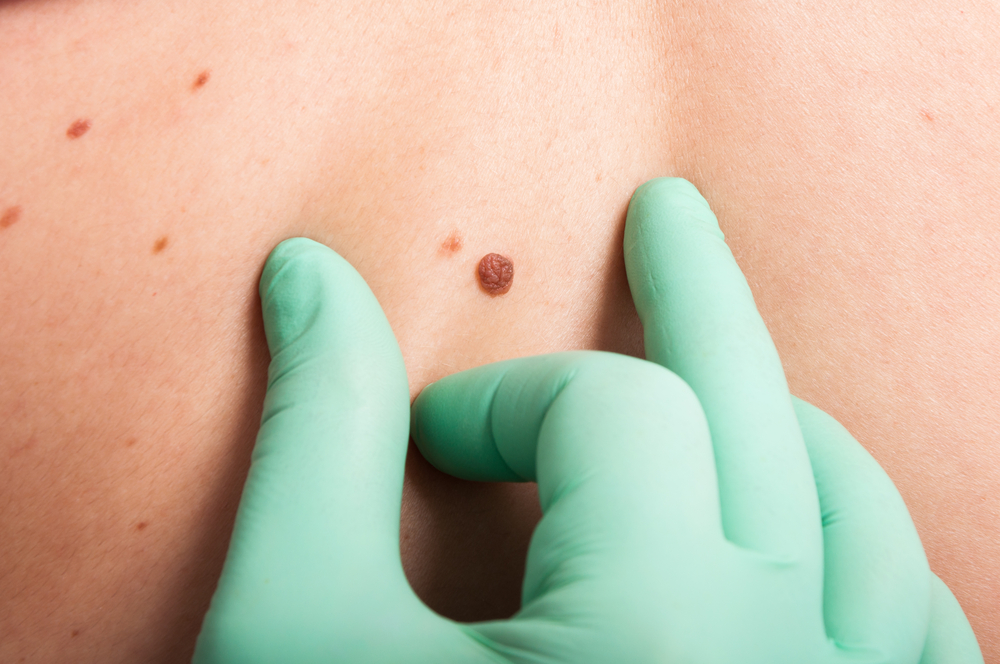
When a strange mole appears on your skin, or an existing one starts changing, it’s natural to feel a wave of worry. The question “Does hair grow on skin cancer?” might even pop into your head. It’s a common concern, and understanding the answer can help put your mind at ease and give you a clearer picture of your skin health.
The truth is, finding a hair growing from a mole doesn’t automatically mean you have skin cancer. Most moles, whether hairy or not, are benign. That being said, knowing the facts about moles, hair growth, and how to spot potential skin cancer symptoms is vital.
As a dermatologist for skin cancer in Bucks County, we offer a full body scan to get a better understanding of some questionable moles you may have. We do recommend frequent visits if you have a ton of moles.
Can Hair Grow on a Skin Cancer Mole?
The hair follicle, the tiny sac from which each hair grows, is independent of the melanocytes, which are the cells that can become cancerous and form melanoma. Most of us have between 10 to 40 moles scattered across our bodies. If a mole happens to form over an active hair follicle, the hair will often continue to grow right through it.
This is simply a coincidence of placement and doesn’t inherently indicate the mole is cancerous. In fact, a study published online in Nature Communications on November 4, 2019, suggests that hair growth from a mole may be a good sign. The study found that melanomas, among the most aggressive forms of skin cancer, frequently originate within oncogenic melanocyte stem cells housed inside hair follicles. Research from Yale University points to hair follicles possessing a special ability to effectively keep mutant cells under control.
While this might sound positive, it’s important to remember that skin cancer can develop in numerous ways, and the presence or absence of hair in a mole isn’t a definitive indicator of anything. What’s most important is being vigilant about all your moles, whether they have hair or not.
Understanding Moles
What Exactly Is a Mole?
Moles occur when skin cells called melanocytes cluster together. Melanocytes give our skin its natural pigment, called melanin. Having a smattering of moles, particularly those developed during childhood or adolescence, is completely normal. While most remain harmless throughout life, monitoring them for changes is crucial.
Identifying Typical Moles
It’s important to be able to distinguish between an average, harmless mole and one that might signal trouble. Here are the key characteristics of typical moles:
- Solid, consistent color throughout, often brown, tan, or black.
- Regular, well-defined borders that are round or oval.
- A diameter that’s typically smaller than a pencil eraser, roughly 6 millimeters.
- They may be flat or slightly raised on the skin.
While a mole having these characteristics generally indicates it’s benign, it’s always wise to discuss any new or changing moles with a dermatologist.
Signs and Symptoms of Skin Cancer: What to Watch Out For
While many moles are harmless, it’s important to be vigilant and recognize the signs of skin cancer. Skin cancer can develop on any part of your body, and early detection is crucial for successful treatment.
Keep these warning signs in mind:
ABCDEs of Melanoma
One of the simplest methods for checking your moles at home is to use the ABCDE rule:
| Letter | Description |
|---|---|
| Asymmetry | If you were to draw a line through the center of the mole, would the two halves match? Asymmetry might mean it’s time to have the mole checked out. |
| Border Irregularity | A benign mole has smooth, even borders. Notched, blurry, or ragged edges can indicate a problem. |
| Color Changes or Variations | Watch for moles exhibiting multiple colors, uneven shading, or those changing color significantly over time. These variations deserve attention. |
| Diameter | Most non-cancerous moles are smaller than the diameter of a pencil eraser (about ¼ inch or 6 mm). Larger moles or those that grow rapidly should be evaluated. |
| Evolving | This “E” encompasses any noticeable change in the mole’s size, shape, color, elevation, or surface. It also includes new symptoms like bleeding, itching, or crusting. Report any evolving mole to a dermatologist promptly. |
Additional Red Flags to Notice
Beyond the ABCDE rule, consider these red flags when evaluating your skin:
- New Mole Growth in Adulthood: While it’s common to develop moles in our younger years, new mole growth past the age of 30 warrants a check-up with your healthcare provider.
- Sores That Don’t Heal: Any sore that doesn’t heal properly, especially if it crusts over, bleeds easily, or remains open for several weeks, requires medical attention.
- Unusual Spots: This could include a scaly patch of skin, a persistent red bump, or a lesion that looks different from your other moles. When unsure, get it examined.
Skin cancers vary in appearance. While melanoma, the deadliest form, is often associated with moles, other common types such as basal cell carcinoma and squamous cell carcinoma may not develop within existing moles. They may even mimic eczema or other common skin conditions. Vigilance and early detection are essential. Remember, it’s always better to have a dermatologist evaluate any concerning skin changes.
Skin Cancer on the Scalp: An Often-Missed Area
Skin cancers on the scalp often fly under the radar, hidden beneath our hair. According to studies, roughly 13 percent of skin cancers develop on the scalp, yet are easily overlooked. Recognizing this risk is especially crucial for individuals with a history of excessive sun exposure or those genetically predisposed to skin cancer. Regular self-exams are important but can be tricky for this area.
Consider asking a family member or friend for help or use a hand mirror to get a clear view. If you’re concerned about a potential skin cancer spot on your scalp, consulting with a dermatologist is the best way to ensure a correct diagnosis.
Other Questions People Have
Can skin cancer have hair growing out of it?
Yes, it’s possible to find hair growing out of skin cancer. While this doesn’t make it any more or less likely to be cancerous, it underscores that the presence of hair isn’t a reliable way to determine if a mole is cancerous.
Why is hair growing on my skin?
Hair grows from hair follicles, tiny sacs embedded in our skin. These follicles are distributed throughout our bodies except for the palms of our hands, the soles of our feet, and our lips. The color and texture of hair depend on factors like genetics and location on the body. If you’re concerned about new hair growth or changes in hair texture, talk to your doctor or a dermatologist.
What does growing skin cancer look like?
Skin cancers vary greatly in appearance. They might appear as:
- A pearly or waxy bump
- A flat, flesh-colored, or brown scar-like lesion
- A firm, red nodule
- A rough, scaly patch that may crust or bleed
- A persistent sore that doesn’t heal
- A raised area with a central depression
- A spot or sore that itches, burns, or hurts
These are just a few examples, and early skin cancer signs might be subtle. If you observe anything unusual or concerning, schedule an appointment with a dermatologist right away. Early detection greatly increases the chances of successful treatment.
Does hair grow on a tumor?
It’s very uncommon for hair to grow directly from a tumor. While some skin cancers, like melanoma, might originate in hair follicles and initially appear as moles with hair, those hairs usually stop growing as the cancerous cells multiply. However, it’s important to remember that skin cancers on the scalp often occur in areas with active hair follicles, so hair may be growing around a tumor but not directly from it.
The relationship between hair growth and skin cancer is more nuanced than many people think. It’s natural to wonder, “Does hair grow on skin cancer?”, and while the answer is “sometimes”, hair growth on a mole isn’t a reason to panic or assume the worst. Regular skin checks, familiarity with your skin’s landscape, and understanding typical vs. atypical mole characteristics remain the best defense against skin cancer. If you notice a mole — hairy or not — exhibiting any unusual signs, err on the side of caution. Consult a qualified dermatologist promptly for diagnosis and guidance.








No comment yet, add your voice below!